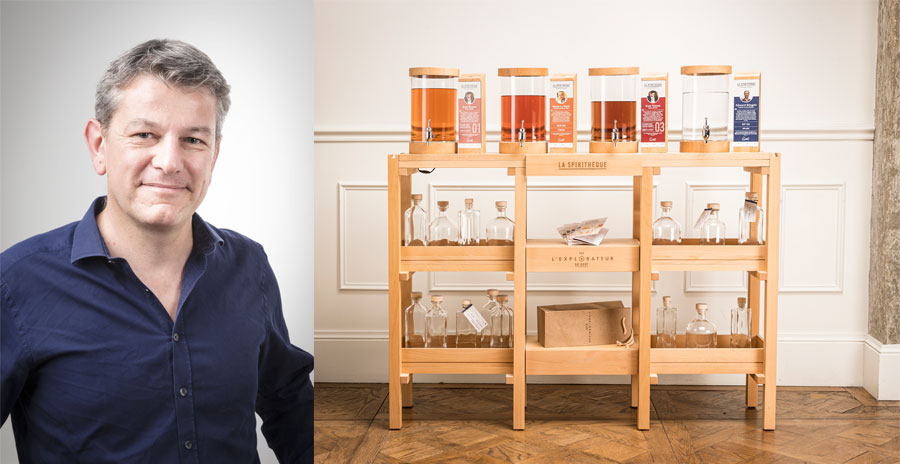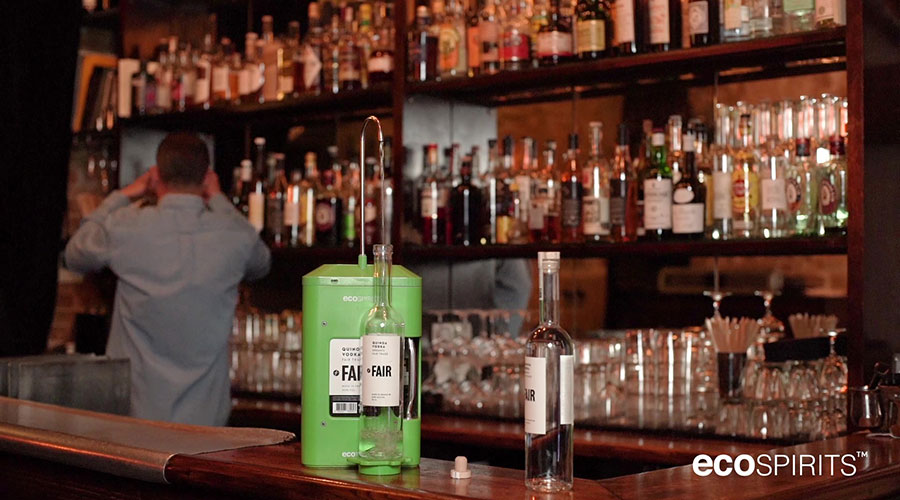Even if the question of the carbon footprint of rums is not yet one of the main purchasing criteria, it is gaining momentum as climate change continues to grow. While the rum industry is making many efforts to make production eco-responsible, logistics and distribution to target markets are still important areas for improvement. Several solutions exist, none of which is a panacea.
Is it ecologically responsible to drink rum? As the issue of climate change becomes increasingly important, it is now reasonable to ask the question. And to provide some answers. First of all, there are the issues linked to the cultivation of the raw material, sugar cane, with the use of pesticides and fossil fuels for the cane cutting machines and tractors. The issue of energy to run the mills and distillation equipment.
The issue of residues or co-products of rum production (bagasse, vinasse, etc.). The question of the water used during the production process… All these subjects have been taken on board by the distilleries, and this section regularly reports on them. Pesticides are used less and less, especially in countries that have to comply with European Union rules (ever-increasing bans on products, timid progress in organic farming, etc.).
The energy needed by the distilleries to operate comes increasingly from bagasse, while solar panels are installed on the administrative and commercial premises. The vinasse is reprocessed, the water too, and systems are put in place to save it… In short, we can say that real progress has already been made, and continues to be made.
A beam in the foot
There remains a thorn, or rather a beam, in the side of rum producers: the carbon footprint of logistics. Most rums are produced a long way from their target markets: for example, there are 9,200 km between Reunion and France, and 6,700 km for Martinique. This means that they have to be transported to the shops where the enthusiasts shop, or even to their homes when they shop online.
A good part of the rums (almost all of the white rum and some of the amber rums) are however sent to France in bulk in large containers, and are bottled on the spot, as close to the market as possible, which helps to reduce the carbon footprint. But a significant proportion, generally the most premium qualities, are bottled at their place of production. The problem is that there is little or no glass industry in the Caribbean, forcing rum producers to import bottles, fill them on the spot and then ship them to the countries where they will be sold.
This is a significant financial and ecological cost, which increases even more when these same premium rums are packaged in cardboard, or worse, in wood or metal. These are also often imported, and make the final product even heavier? These premium rums are also often bottled in more prestigious, more elaborate and heavier bottles. To top it all off, they are sometimes closed with corks that also weigh an obscene amount.
Stop over-packaging
The first thing to do would be to ban the vast majority of over-packaging (cardboard, wood, metal and others), which, as Thomas Gauthier of the French Spirits Federation says in his interview (see below), “goes straight into the bin once the product has been bought”. The good news is that the industry is seriously considering to eliminate over-packaging for the vast majority of spirits bottles.
Another avenue is to stop using ornamental corks and heavy bottles. Moreover, as Jean-Pierre Cointreau (president of the FFS) said in the same interview, export markets require that bottles do not exceed a certain weight in order to enter the country. The rum industry already knows how to do this and is working on the eco-design of bottles, so it would be enough to generalise these ecologically virtuous practices. This would mean that consumers would have to stop believing that the heavier and more pretentious the bottle, the better the product.
Recycling, an imperfect solution
Another solution is the recycling of glass bottles. Here, we have to admit that the sector is rather good: “the glass in our bottles is 88% recyclable”, Jean-Pierre Cointreau tells us. And more and more producers are incorporating recycled glass into their bottles. The Pernod-Ricard group has even gone as high as 81% recycled glass in some of its products. However, it is not common to see bottles made from 100% recycled glass, as they lose strength and homogeneity.
Recycling is therefore very well used by the industry and is its preferred solution for reducing its carbon footprint. But it is not a panacea either. The process also produces a lot of CO2. The glass has to be collected and transported to storage sites and then to the glassmakers’ furnaces, most often using vehicles powered by carbon energy. In addition, the temperature of the furnaces used to melt the glass must be raised to 1,300°.
There are many experiments on alternatives to glass.
For example, the Pernod-Ricard group has brought out the first generation of paper bottles for its Absolut vodka, which is made of 57% FSC-certified biodegradable paper and 43% recycled plastic film. There are also natural fibre bottles. For example, the company Lyspackaging offers bottles made from bagasse and corks made from the last juice of the molasses! The solutions exist, but they do not yet seem to be fully developed and the generalisation of alternatives to glass does not seem to be for tomorrow.
In 2023, Bacardi announced that it would replace the fossil-based plastic in 80 million bottles with Danimer Scientific’s biopolymer by 2023. It is now 2023 and at the time of writing it is not clear where this project stands.

The difficulty of reuse
There remains the solution of reuse, in other words, the good old deposit. Until the 1980s, this was a widespread practice in France. It made it possible to reuse glass bottles without having to recycle them. But getting a re-use sector up and running again is likely to be complicated. Firstly, because the French are used to recycling their glass. Secondly, the spirits sector is characterised by a wide variety of bottle shapes. It would therefore be difficult to classify the collected bottles according to the brand to which they belong, and then send them back for refilling. This solution is clearly not favoured by the industry, even though it is increasingly being promoted by public authorities.
However, locally, initiatives are being put in place, for example at Neisson in Martinique. We’ve been experimenting with deposits on our 50 and 50% white rum bottles for a year now. These are screen-printed bottles, with the Ti’Punch doses on the side, but it didn’t really work,” says Grégory Neisson. Since the beginning of 2023, we have decided to move up a gear and buy back the 50 cent bottles to motivate people. We also chose a new glue that allows the labels to be removed with water and washed better before being reused.
The CHR and ecoTOTE
Some retailers have also set up distribution channels that allow for some degree of reuse. For example, the Maison du Whisky (LMDW) launched in ecoSPIRITS in January 2022 in France (the concept itself having been created in Singapore and dating from 2018).
Constance Moreau-Luchaire, ecoSPIRITS manager at La Maison du Whisky explains how the concept works: “the spirits producer sends IVCs (containing 220, 500 or 1,000 litres) to the warehouse in Saint-Ouen-l’Aumône in the Paris region.
There the spirit is repackaged in ecoTOTES, 4.5 litre glass bottles, protected by an aluminium shell and a recycled and recyclable plastic shell. The latter is sent to the CHR circuit (cafés, hotels, restaurants, etc.) where the manager receives it. Two options are then available to him. Either opt for a pouring spout that allows him to reuse bottles of the brand that he already owns.
Alternatively, we recommend that they buy 3 to 6 bottles of the brand so that they can position them prominently behind the bar. Or opt for a very precise pouring system that allows them to fill the glasses directly with the desired quantity of liquid (2, 4 cl or more). Here again we recommend that there is at least one bottle visible on the back bar. Once the ecoTOTE is empty, we collect it, wash it, refill it and reuse it.
For the moment, only the Plantation brand, for its Tristar, the original Dark and the Pineapple, have opted for this system in the rum world. In 2022, 5,200 ecoTOTES saved around 18 tonnes of CO2, the equivalent of 12,000 return trips from Paris to Bordeaux by TGV, 83,000 km by car (or 54 return trips from Paris to Marseille), 18 return trips from Paris to New York by plane or more than 281,000 hours of video streaming.
The solution only applies to the CHR and to ranges that have a high turnover, but LMDW will launch a similar service for wine merchants. They will be offered a selection of exclusive batches that will only be available in ecoTOTES. The wine merchant will be able to fill the bottle that his customer brings back, or use it to pour tasting glasses. The label will be changed each time if the product is different.
Through a partnership with Maison Richard, ecoSPIRITS is currently only used in the Paris region, Burgundy and Champagne, but the system will spread throughout France in 2023. And the Pernod-Ricard group is testing the system in Singapore.
The Spirithèque, or qualitative bulk wine
This shift from bulk to premium and to the wine merchant distribution channel has already been implemented by the distributor L’Explorateur du Goût, with its Spirithèque. The sale of wine and spirits in bulk was often associated with entry-level products at low prices,” explains its creator François Sommer.
With the Spirithèque, we have imagined a bulk distribution system whose design and quality content reassure consumers who wish to buy spirits, while at the same time being ecologically responsible. The spirits first arrive at the Taste Explorer in IVCs that can hold 1,000 litres, then they are packaged in bibs, before being delivered to the wine merchants who have installed the furniture that accommodates the Spirithèque, which is made in France from FSC-certified beech wood.
There, the spirit is decanted into 5-litre bottles made of recycled glass. When a customer wants to buy a spirit from the Spirithèque, the wine merchant fills an attractive bottle supplied with the device and takes it away. He will return it when it is finished so that it can be refilled with the same or another spirit. At the moment, three rums are available in the Spirithèque: a 50° white agricultural rum from the Fish distillery, a 5-year-old rum from Trinidad & Tobago Zaka, and a rum from the Scottish bottler Rum & Cane, which is a blend of rums from the Dominican Republic and Cuba.
Sailing is on the rise
Even when packaged in bulk in large vats, rum crosses the oceans on huge container ships that run on fuel oil. But there is an alternative: transport by sail. Even if it is still confidential, more expensive and takes longer, this solution is developing. For example, Les Frères de la Côte will be fitting out a second sailing ship, while TOWT plans to launch its first cargo ship in December 2023 (and three more by 2026).

